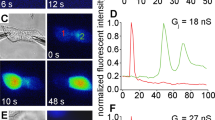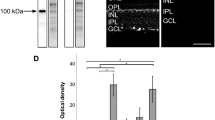Abstract
A major function of glial cells in the central nervous system is to buffer the extracellular potassium concentration, [K+]o. A local rise in [K+]o causes potassium ions to enter glial cells, which have membranes that are highly permeable to K+; potassium then leaves the glial cells at other locations where [K+]o has not risen. We report here the first study of the individual ion channels mediating potassium buffering by glial cells. The patch-clamp technique was employed to record single channel currents in Müller cells, the radial glia of the vertebrate retina. These cells have 94% of their potassium conductance in an endfoot apposed to the vitreous humour1, causing K+ released from active retinal neurones to be buffered preferentially to the vitreous2,3. Recordings from patches of endfoot and cell body membrane show that a single type of inward-rectifying K+ channel mediates potassium buffering at both cell locations. The non-uniform density of K+ conductance is due to a non-uniform distribution of one type of K+ channel, rather than to the cell expressing high conductance channels at the endfoot and low conductance channels elsewhere on the cell.
This is a preview of subscription content, access via your institution
Access options
Subscribe to this journal
Receive 51 print issues and online access
$199.00 per year
only $3.90 per issue
Buy this article
- Purchase on Springer Link
- Instant access to full article PDF
Prices may be subject to local taxes which are calculated during checkout
Similar content being viewed by others
References
Newman, E. A. Nature 309, 155–157 (1984).
Newman, E. A., Frambach, D. A. & Odette, L. L. Science 225, 1174–1175 (1984).
Newman, E. A. & Odette, L. L. J. Neurophysiol. 51, 164–182 (1984).
Hamill, O. P., Marty, A., Neher, E., Sakmann, B. & Sigworth, B. Pflügers Arch. ges. Physiol. 391, 85–100 (1981).
Sakmann, B. & Trube, G. J. Physiol. Lond. 347, 641–657 (1984).
Kurachi, Y. J. Physiol. Lond. 366, 365–385 (1985).
Ohmori, H. J. Physiol. Lond. 311, 289–305 (1981).
Fukushima, Y. J. Physiol. Lond. 331, 311–331 (1982).
Standen, N. B. & Stanfield, P. R. J. Physiol. Lond. 294, 497–520 (1979).
Newman, E. A. Nature 317, 809–811 (1985).
Newman, E. A. Science 233, 453–454 (1986).
Author information
Authors and Affiliations
Rights and permissions
About this article
Cite this article
Brew, H., Gray, P., Mobbs, P. et al. Endfeet of retinal glial cells have higher densities of ion channels that mediate K+ buffering. Nature 324, 466–468 (1986). https://doi.org/10.1038/324466a0
Received:
Accepted:
Issue Date:
DOI: https://doi.org/10.1038/324466a0
This article is cited by
-
Functional specialization of retinal Müller cell endfeet depends on an interplay between two syntrophin isoforms
Molecular Brain (2020)
-
Three distinct types of voltage-dependent K+ channels are expressed by M�ller (glial) cells of the rabbit retina
Pfl�gers Archiv European Journal of Physiology (1994)
-
Non-vesicular release of glutamate from glial cells by reversed electrogenic glutamate uptake
Nature (1990)
Comments
By submitting a comment you agree to abide by our Terms and Community Guidelines. If you find something abusive or that does not comply with our terms or guidelines please flag it as inappropriate.



